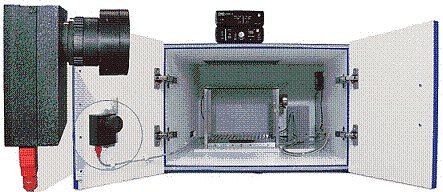Infrared spectroscopy was one of the earliest techniques to be used for the structural studies of polypeptides and proteins (
1 ,
2 ). However, a major difficulty that limited earlier studies of such biological molecules was the absorption of liquid H
2 O, which shows strong absorption over much of the fundamental region of the infrared spectrum. This severely limited the analysis of biological molecules in their native state, and necessitated the use of dry films, KBr disks, or D
2 2O as a solvent. There is no strong absorption from D
2 O, in the region 1700–1500 cm
-1 and this spectral region is one which is particularly important for the study of polypeptides and proteins. The infrared spectra of liquid H
2 O and for comparison liquid D
2 O are shown in Fig. 1 . The recent development of computerized FT-IR (Fourier transform infrared) instrumentation now permits the subtraction of background water absorptions from dilute samples (
3 ,
4 ) and, hence, enables the study of biomolecules in their more natural environment, e.g., H
2 O, buffer solutions, and so on. This approach has revolutionized the application of infrared spectroscopy for the study of biological molecules.
Fig. 1. FT-IR transmittance spectrum of H2 O (continuous line) and of D2 O (broken line) recorded in a calcium fluoride cell fitted with a 6�m tin spacer. The spectra were recorded at 20�C. The peaks shift to lower wave numbers in D2 O.








